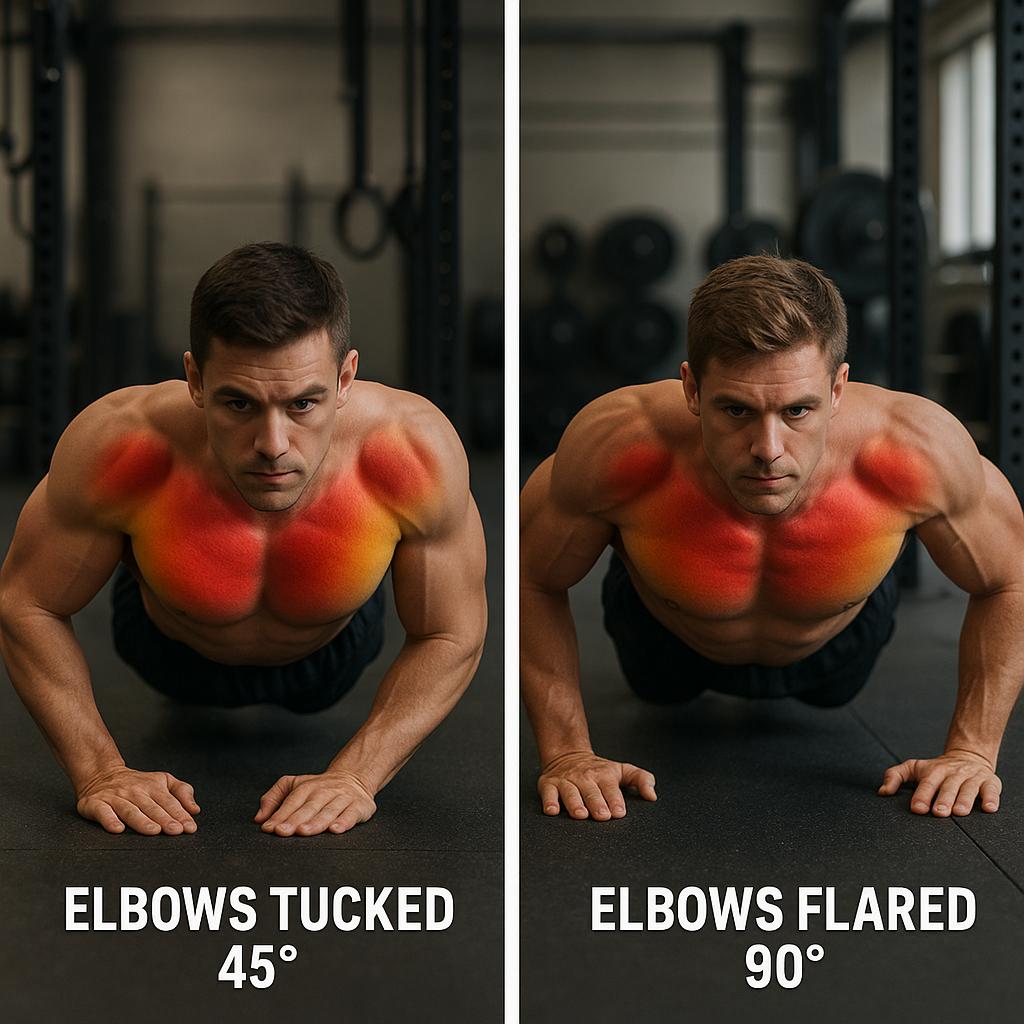The best way to do pushups is with your elbows tucked in at about a 45-degree angle from your torso, rather than flaring them out to the sides. This form not only targets your chest and triceps more effectively, but also protects your shoulders from injury. Mastering proper elbow placement is crucial for safe, effective pushups—regardless of your fitness level.
Understanding pushup technique helps you maximize muscle activation, avoid common injuries, and get the most benefit from every rep. In this guide, you’ll learn exactly how elbow position impacts your results, the latest research, and how to adjust your form for specific goals.

What’s the Difference? Elbows In vs. Elbows Out Pushups
- Pushups with elbows in (tucked at about 45°):
- Activate more chest and triceps muscle fibers.
- Reduce stress on the shoulder joint.
- Mimic the safe arm path used in bench presses.
- Pushups with elbows out (flared at 70–90°):
- Shift work toward the shoulders.
- Increase the risk of shoulder impingement and wrist strain.
- Shorten the movement’s range of motion, reducing effectiveness.
A recent 2024 study published in ScienceDirect found that elbow angles below 60° provide significantly better chest activation and joint safety compared to flared elbow positions.
Why Elbow Position Matters for Pushups
Proper elbow angle changes how pushups load your muscles and joints.
Tucking your elbows:
- Keeps your upper arms in line with your torso, spreading tension across the chest, shoulders, and triceps.
- Prevents the “shoulder flare” that can compress sensitive tissues and lead to rotator cuff problems.
Letting your elbows flare out:
- Puts extra torque on the shoulder capsule.
- Can lead to overuse injuries, especially with high reps or poor shoulder mobility.
- Activates the front deltoid more and limits pec/triceps development.
“Keeping the elbows tucked, scapula depressed is the best way to protect the shoulders and keep the movement focused on triceps and chest.”
—r/bodyweightfitness (source)
Which Elbow Position Is Best for Your Goals?
| Goal | Best Elbow Position | Details |
|---|---|---|
| Chest development | 45° (tucked) or slightly wider | Maximizes pec activation, safest for joints |
| Triceps development | Elbows close (near ribs) | Diamond or military pushups emphasize triceps |
| Shoulder development | Elevated feet or pike style | Specialized variations for front delts |
| General fitness | 45° tuck | Best mix of safety and muscle engagement |
Most people should default to a 45-degree elbow angle for classic pushups. Adjust only if you’re advanced and training for a specific target area.
Common Mistakes and How to Fix Them
- Flaring elbows too wide:
Solution: Keep elbows angled back toward your ribs, not out at shoulder height. - Hands too far forward:
Solution: Place hands directly under shoulders, screw them into the floor for stability. - Sagging hips or arched back:
Solution: Brace your core, keep your body in a straight line from head to heels. - Half reps:
Solution: Lower your chest all the way to within an inch of the ground for full range.
Step-by-Step: Proper Pushup Form With Elbows In
- Start in a plank: Hands slightly wider than shoulders, body straight.
- Engage your core and glutes.
- Bend your elbows at a 45° angle as you lower your chest toward the floor.
- Keep elbows tucked (not touching ribs, but not flared out).
- Lower until your chest nearly touches the ground.
- Push back up, keeping your elbows at the same angle.
- Repeat for desired reps.
When Are Elbows Out Pushups Appropriate?
Some advanced athletes use a slightly wider elbow angle (up to 60°) for variety or chest emphasis, but this is not recommended for most people.
Never let elbows flare to 90° (straight out to the sides), as this increases injury risk with little benefit.
For shoulder-specific training, opt for pike pushups or feet-elevated pushups rather than unsafe wide-elbow positioning.
For more, see the Built With Science pushup form guide (2024).
FAQ: Pushup Elbow Position
Q: Is elbows-in pushup harder?
A: Yes, because it increases triceps activation and often provides a greater range of motion.
Q: Can I switch elbow positions for variety?
A: Yes, but always prioritize safe angles. Use close grip for triceps and 45° for chest.
Q: How do I know if my elbows are too flared?
A: Record yourself from above—if elbows are at or above shoulder height at the bottom, bring them in.
Conclusion
For the safest, most effective pushup, keep your elbows in at a 45-degree angle from your torso. This targets the chest and triceps, protects your shoulders, and gives the best overall results. Avoid flaring your elbows out—save that for advanced variations, and only if you have the mobility and experience.
Ready to improve your pushup form? Start today with elbows in for better strength, muscle growth, and injury prevention.
Try recording your next pushup set and check your elbow angle—you’ll feel the difference!
